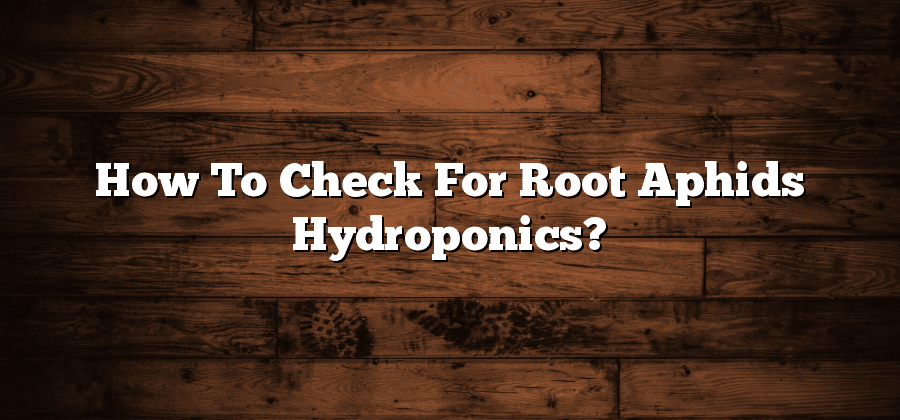I. Introduction to Root Aphids in Hydroponics
Hydroponics, a method of growing plants without soil, has quickly gained popularity among gardeners and commercial growers alike. This innovative technique offers numerous benefits, including increased plant yields and efficient use of resources. However, like any other form of agriculture, hydroponics is not immune to pests, and one such pest that can wreak havoc on hydroponic systems is the root aphid.
Root aphids, also known as soil aphids or plant lice, are tiny insects that feed on the roots of plants. These pests can cause significant damage to the root system, leading to stunted growth, reduced yields, and even plant death. Unlike their above-ground counterparts, root aphids are often hidden from view, making it difficult to detect their presence until the damage becomes apparent. Therefore, it is crucial for hydroponic growers to familiarize themselves with the signs and symptoms of root aphids in order to effectively manage and control infestations.
2) Symptoms and Signs: Recognizing the Presence of Root Aphids
Symptoms of root aphid infestation in hydroponic systems can vary depending on the severity of the problem and the plant species involved. One common indication of root aphids is the presence of sticky or honeydew-like substances on the plant foliage or surrounding surfaces. These sticky residues are a result of aphids excreting a sugary substance known as honeydew, which serves as a food source for ants and can promote the growth of black sooty mold. Additionally, wilting or yellowing of leaves, stunted or distorted plant growth, and overall poor plant vigor are often observed when root aphids are present.
Another sign of root aphid infestation is the presence of small, oval-shaped insects on the roots or in the growing medium. These pests are usually light yellow or brownish in color and can be difficult to spot due to their size and ability to hide in the root system or in crevices within the growing medium. Careful inspection of the roots, either by gently removing the plants from the hydroponic system or by using an endoscope or magnification tools, may reveal the presence of these pests. It’s important to note that root aphids can reproduce rapidly, so early detection and intervention are crucial to prevent further damage to the plants and the hydroponic system as a whole.
3) Examining the Root System: Checking for Damage and Infestation
When it comes to the health of your hydroponic plants, one crucial aspect to monitor is their root system. Root aphids, a common pest in hydroponics, can cause serious damage if left unchecked. Examining the root system regularly is essential to identify any signs of damage or infestation early on.
Start by carefully inspecting the roots for any visible signs of aphid activity. Look for tiny, pear-shaped insects crawling on the roots or hiding in crevices. Some root aphids may also leave behind a sticky residue or honeydew, which can attract other pests or lead to the growth of mold. Additionally, pay attention to the overall health of the roots themselves. Healthy roots should be white or cream-colored, firm, and free from any unusual discoloration or rot. Any signs of wilting or browning may indicate a problem, as root aphids can weaken the root system, impairing its ability to absorb nutrients and water efficiently.
4) Inspecting the Foliage: Identifying Aphid Activity on Leaves
Inspecting the foliage is a crucial step in identifying aphid activity on leaves. These tiny pests can cause significant damage to plants, and their presence can be detected through careful observation. One of the most common signs of aphids on leaves is the presence of sticky honeydew residue. Aphids feed on plant sap, and as a result, they excrete a sugary substance called honeydew. This sticky residue can attract ants and can also lead to the growth of black sooty mold on the leaves. So, if you notice an abundance of ants or blackish discoloration on the leaves, it could be a clear indication of aphid infestation.
Another noticeable sign of aphid activity on leaves is the presence of distorted or curling foliage. Aphids insert their needle-like mouthparts into the plant tissue to suck out the sap, and this feeding behavior can cause the leaves to become deformed and twisted. You may also spot small, soft-bodied insects on the undersides of the leaves. Aphids come in various colors, from green and brown to yellow and black, so they can blend in with the leaf color. Therefore, it is essential to inspect both the upper and lower surfaces of the leaves to ensure accurate identification of aphid infestation.
5) Monitoring Growth Patterns: Noticing Stunted or Distorted Plant Development
As hydroponic growers, one of the key aspects to monitor in our plants is their growth patterns. Healthy plants should exhibit steady and uniform development, however, the presence of root aphids can disrupt this normal growth. One of the telltale signs of root aphid infestation is stunted or distorted plant development.
When plants are infested with root aphids, their growth can be visibly affected. Instead of growing uniformly, plants may show signs of stunted growth, with smaller leaves and shorter stems than expected. Additionally, the overall development of the plant may appear distorted, with parts of the plant growing at different rates or in unusual directions. These irregular growth patterns should raise a red flag for hydroponic growers, indicating the possible presence of root aphids and the need for immediate action.






